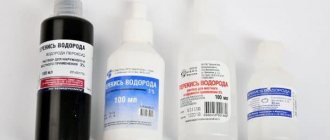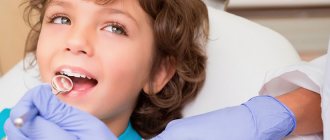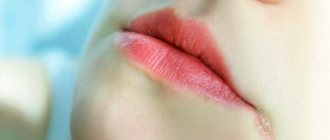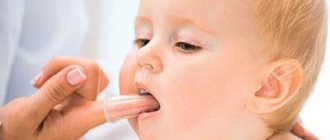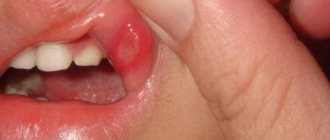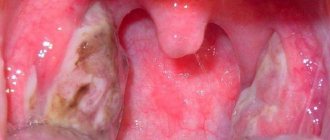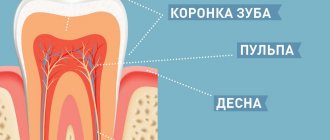Symptoms
The varicella-zoster herpes virus is transmitted through airborne droplets. Invading the oral cavity during breathing, it reaches the mucous membranes, and there it infects cells, forcing them to reproduce themselves. Places of successful expansion form single transparent papules, which soon, due to disruption of integrity during food intake, turn into ulcers. The wounds may bleed and cause severe discomfort.
Chickenpox in the mouth in adults is accompanied by the following symptoms:
- high body temperature;
- rashes on the skin;
- fever;
- chills;
- a sore throat;
- characteristic non-purulent rashes appear on the mucous membranes of the oral cavity: gums, larynx, tonsils, inner cheeks, tongue, palate, pharynx.
Chickenpox in a child’s mouth: how to treat the mucous membrane and how to treat chickenpox?
The route of transmission of chickenpox is predominantly airborne.
The infectious agent enters the body and reaches the mucous membranes. We recommend reading this article about possible routes of transmission and infection of chickenpox. After completion of the incubation period, the disease manifests itself with fever, weakness, catarrhal symptoms - runny nose, cough, and, finally, rash. We wrote more about the stages of the incubation period here.
Most often, chickenpox rashes are localized on the skin, especially in young children who suffer from a mild form of infection.
In children, it is rare, but still moderate to severe and severe forms of chickenpox are observed. They are characterized by rashes not only on the skin, but also in the mouth and genitals. Read about the specifics of chickenpox in infants and children under one year old here.
In adolescents and adult patients, this course of the disease is more common.
The rash in the mouth is localized:
- on the patient's tongue;
- on the inside of the cheeks;
- on the palate and gums;
- on the inner surface of the lips.
As soon as they appear, pimples in the mouth quickly turn into blisters that burst, becoming ulcers. These erosions sometimes go away on their own, and patients do not even feel any anxiety.
But more often, ulcerated wounds make themselves felt with pain and discomfort in the mouth. They will tighten and heal over time.
The difference between blisters on the oral mucosa is that they do not crust over like skin rashes.
Often a rash in the mouth is accompanied by a rise in temperature. Ulcers may not heal for a long time, because the environment in the oral cavity is always moist. At the same time, it is difficult for the patient to chew and swallow due to pain in the larynx.
Rashes on the mucous membranes are dangerous because they can provoke a secondary infectious disease. Such a reaction of the body is possible if the patient has inflamed tonsils or adenoids, caries and other sources of infection are present.
Breathing problems can occur when a bacterial infection begins to develop against the background of chickenpox.
You can find out what other symptoms chickenpox exhibits by following the link.
Causes of chickenpox
Chickenpox is transmitted by airborne droplets and is easily transmitted by children. In adults who have not had it before, it is severe, usually with complications. The onset of the disease is accompanied by general malaise and rising temperature. Next, a rash appears, which is localized on the back of the head, back, face, and stomach.
An itchy rash develops from a spot stage to a vesicle, which becomes crusty. If bacteria enter, suppuration, formation of pustules, erosions, and scars are possible. The rash stage in children and adults lasts from 2 to 10 days. Rashes on the tongue and mouth (as in the photo) are a signal that the disease is severe and a secondary infection may develop.
The cause of chickenpox is the penetration of the herpes virus into the body, the susceptibility to which in people is quite high. The carrier of the virus is contagious for 10 days of the incubation period and 7 days from the moment of the first rash. More than 70% of the population suffer from the disease in childhood.
A skin rash is normal with chickenpox. Rashes in the oral cavity, genital area and respiratory tract are a complication and can be caused by the following reasons:
- chronic illnesses;
- decreased immunity;
- weakened body after illness;
- taking cytostatics and glucocorticosteroids (they are prescribed to adults).
How to treat chickenpox in a child's mouth
Parents need to be prepared for the fact that chickenpox will manifest itself not only as skin rashes. Many people do not suspect that there is a danger of developing a rash on the child’s mucous membranes.
And adult patients even more should know how to treat vesicles in the mouth. They rarely have the disease without blisters and ulcers in the mouth.
Parents should be sure to tell their pediatrician if their child has a rash in their mouth. This means that the disease is more severe than usual.
A mild course is more common, so mothers and fathers are not prepared for such a manifestation of the infection.
In special cases, children are even hospitalized to prevent the rash from spreading and becoming infected.
Chickenpox in the mouth must be carefully treated. But self-medication is dangerous.
Let the doctor decide which remedies are suitable for a particular child, taking into account his well-being and individual characteristics. This is what the authoritative pediatrician Evgeniy Komarovsky thinks.
According to the pediatrician, the use of any medicine must be agreed with the attending physician. After all, what works for one child may not work for another.
Traditionally, for chickenpox rashes the following is prescribed:
- Chlorophyllipt is a product based on eucalyptus leaf extract. An oil solution is used to lubricate the ulcers. It has antiseptic and anti-inflammatory effects.
- Miramistin is an antiseptic with a pronounced antimicrobial and immunostimulating effect. The drug also accelerates wound healing.
- Solcoseryl - this paste protects the mucous membrane from infections, helps heal ulcers on the mucous membrane and activates recovery processes. After application, the product lasts from 3 to 5 hours.
- Lysozyme - the drug is diluted in a solution of novocaine or sodium chloride. It is an antimicrobial and antibacterial agent of natural protein origin.
- Acyclovir is an antiviral drug effective in treating herpes. Chickenpox is caused by herpesvirus type 3. Use eye ointment; skin cream should not be applied to mucous membranes.
- Cholisal - this dental gel is effective for mouth ulcers with its antimicrobial, anti-inflammatory and analgesic effects.
- Kamistad and Kalgel - these drugs, which are used for teething, have an analgesic effect. They are good for treating painful rashes in the mouth. Gels will also protect the mucous membrane from infections.
- Propolis - a pharmacy tincture is diluted with water before lubricating the wounds in the oral cavity.
- Sea buckthorn oil - this product disinfects the oral mucosa and at the same time softens it, promoting the healing of ulcers.
Gels, creams and solutions are used to treat the affected areas several times a day. You can eat food no earlier than half an hour after treatment.
A remedy such as methylene blue, which is popular for treating skin rashes, is best not used in the mouth.
There are many other, more suitable drugs that have a gentle effect on the oral mucosa.
If the wounds hurt and itch very much, ice cubes are often used. But this remedy is not suitable for small children.
Before smearing the wounds, you should check whether there will be an allergy to the use of the drug. You need to apply the product to the wrist area, if after a day there are no reactions, you can treat erosions in the oral cavity with it.
You need to use the medications prescribed by your doctor until the rash in your mouth is completely cured.
Treatment methods
Almost everyone knows how to treat chickenpox in the mouth. To avoid injury to ulcerative formations in the oral cavity, it is recommended to give children food with a semi-liquid consistency.
These are broths made from chicken or vegetables, porridge with milk, pureed soups, fruit purees, yoghurts. Stop “friendship” with sour, salty and spicy foods during the illness. After eating, it is better to rinse your mouth with water or an antiseptic every time.
You need to drink more fluids so that toxins are eliminated from the body faster.
For faster healing of wounds, it is recommended to use the following products:
Source: https://cosmeton.ru/detskie-zuby/vetryanaya-ospa-vo-rtu.html
Development and course of the disease
Initially, the patient’s general condition noticeably worsens, he suffers from weakness, fatigue, migraines, and often develops a fever. In parallel with this, rashes appear in waves. The initial stage of chickenpox development lasts no more than 3-6 days, but if we are talking about a severe form of the disease, it can last up to 10 days. Each new attack of rash is accompanied by an increase in temperature, which is quite difficult to reduce.
Development and course of the disease
A rash in the mouth causes discomfort. This is something between stomatitis and a cold: it hurts the patient not only to chew, but also to swallow. But the main danger of a rash in the mouth is that it can lead to the development of a secondary infectious disease. In most cases, this reaction occurs with caries, inflammation of the tonsils, adenoids and other sources of infections. Moreover, ulcers may appear in the larynx and other mucous membranes of the respiratory tract, making breathing difficult. The risk of respiratory problems is especially high if some bacterial infection develops in parallel with chickenpox.
Causes
Chickenpox occurs due to the penetration of the herpes virus into the body. The disease is contagious and is transmitted by airborne droplets. After a bacterial infection enters the body and the subsequent immune reaction in the blood, antibodies are produced to this herpes virus.
So that a child or an adult patient who has pimples in the oral cavity can normally tolerate the unpleasant itching sensations, complex therapy is carried out.
Re-infection cannot be ruled out, but is observed in rare cases. This occurs as a result of total suppression of the immune system, for example, with AIDS.
Nutrition
With chickenpox, eating becomes difficult because... painful to swallow.
To make the process of eating less uncomfortable, you must adhere to the following rules for creating a menu:
- consume foods in liquid or semi-liquid consistency;
- exclude solid foods;
- It is prohibited to consume pickles and spices, sweets;
- maintain a drinking regime, which is especially important when a person has a fever: high temperature accelerates the removal of fluid from the body, disrupting the water balance. It is recommended to consume large quantities of fruit drinks, teas, compotes and plain boiled water. You can drink mineral water, but without gas.
All food products should be enveloping. The menu consists of milk porridge, soups and broths with ground vegetable and meat ingredients. If you have chickenpox, you need to eat lean meats, preferably chicken, which has a soft texture.
It is recommended to give dairy and fermented milk products, especially yoghurts and kefir. Among fruits, preference is given to bananas (more details here).
After each meal, you should rinse your mouth with plain water and disinfectant solutions to prevent food particles and bacteria from entering the sores.
General treatment regimen
Treatment of chickenpox in the mouth is carried out according to a standard treatment regimen, which includes several areas of therapy:
- Antipyretic drugs – children are recommended to take antipyretic drugs, which significantly alleviate the child’s condition. The drug “Panadol” with the active ingredient paracetamol for a child is calculated at 20 mg/kg per kilogram of weight. Take three times a day. Another effective remedy against fever is Nurofen (the active ingredient is ibuprofen). It is given to children in the form of a suspension at the rate of 10 mg per kilogram of weight, taken four times a day. Usually these drugs are enough to bring down even high temperatures. The use of Aspirin (acetylsalicylic acid) for children is strictly prohibited so as not to cause toxic damage to the liver.
- Antihistamines - drugs to reduce itching and burning are recommended to be given to children so that they do not scratch the vesicles with chickenpox. Young children need to take Fenistil with the active substance dimethindene maleate 5-7 drops three times a day, and older patients can take Suprastin (the active substance is chloropyramine) half a tablet twice a day.
- Treatment of the rash is a mandatory step in the treatment regimen for the disease. Traditionally, a solution of brilliant green is used to treat rashes, but its effectiveness is quite low. The main purpose of marking vesicles is to see when they stop appearing. In order for the bubbles to dry, it is necessary to rinse them with Fukortsin, Castellani liquid, and a decoction of medicinal herbs.
- Proper drinking regimen and dietary nutrition are another direction in the treatment of chickenpox. It is extremely important to give your child more to drink in order to remove metabolic products and toxins from the body. Dietary foods must be hypoallergenic.
If the disease is atypical and the child has complications, then the treatment regimen for chickenpox in the mouth must include immunomodulatory, antiviral and sedative drugs.
Drug therapy
The oral cavity should be rinsed with clean water and a suitable antiseptic solution after each meal. The following solutions are suitable for this:
- Furacilina.
- Boric acid.
- Miramistina et al.
The treatment regimen prescribed by the doctor depends on the general condition of the patient. If the child is in the hospital, then based on symptoms and changes during treatment, the attending physician adjusts the prescription every few days. If the child is being treated at home, then it is worth ensuring that he has regular doctor’s examinations, and if there is obvious deterioration, immediately go to the hospital.
Therapy for chickenpox
To speed up the healing of wounds, they can be treated with Chlorophyllite - this will prevent the development of a bacterial infection. You can use ointment-like preparations: Solcoseryl, Kamistad. A good way to anesthetize and disinfect the mucous membrane is lotions with lysozyme diluted in a weak solution of novocaine.
It is worth remembering that after lubricating wounds in the mouth with ointments and other medications, you need to refrain from eating for at least half an hour, and give the child something to drink only through a straw.
During the treatment process, it is very important not to harm the mucous membrane with excess drugs. Under no circumstances should you lubricate the elements of rashes in your mouth with brilliant green, iodine or alcohol. This will cause a chemical burn to the membranes of the mouth, and will only complicate the healing process. Follow the doctor's recommendations and use only the drugs and products prescribed by him.
Complications and consequences
Chickenpox in the mouth can cause a number of complications if preventive measures are not taken. Ulcers on the mucous membrane, formed after pimples burst, provide a breeding ground for pathogenic microflora.
If a child constantly puts his hands in his mouth or forgets to rinse his mouth after eating, bacteria settling in the wound begin to multiply rapidly.
If a child constantly puts his hands in his mouth or forgets to rinse his mouth after eating, bacteria settling in the wound begin to multiply rapidly and lead to infection, which can only be cured by long-term antibiotic therapy.
The risks of complications are high in patients with chronic respiratory diseases or acute adenoiditis, inflammation in the throat, which is accompanied by chickenpox.
Traditional methods
Chickenpox can be combated by means prepared according to alternative medicine recipes. With their help, you can activate the process of acne maturation and healing of ulcerations on the mucous membranes, reduce the intensity of itching and pain, and prevent the occurrence of possible complications.
To speed up recovery, follow these recommendations:
- Wipe the affected areas of the mucous membranes of the mouth with black or green tea, decoctions of medicinal herbs (clover, yarrow, chamomile, string, dandelion).
- Treat the tongue, larynx, gums and cheeks with tinctures of propolis and calendula.
- After eating, gargle with sage decoction.
The following can help reduce the intensity of unpleasant symptoms:
- Parsley decoction. Greens (1 tbsp) are poured into a glass of boiling water. Infuse for an hour, filter. The composition is drunk three times a day, 1 tsp.
- Soda. Pour boiled water into a glass, add 1 tsp. soda Rinse your mouth with the solution several times a day. The procedure helps fight itching.
- The ice cube is rolled with the tongue like candy. Cold helps reduce itching and relieve swelling.
If the wounds do not heal well, it is recommended to lubricate them with tea tree oil or aloe juice.
Chickenpox in a child’s mouth: how to treat mucous membranes and gargle
Chickenpox is a herpetic viral disease that affects the structures of the dermis. However, it also happens that herpetic papules are located in the oral cavity, on the mucous membranes of the nose and tongue.
Chickenpox in the mouth of a child and an adult is an alarming sign indicating an extensive spread of the process. This is fraught with the development of severe complications.
How can you treat a chickenpox rash in a child’s mouth?
What drugs are used
Rashes in the mouth due to chickenpox can be treated with various groups of medications:
- Antihistamines. Smallpox papules cause irritation of itching mediators; with this property, chickenpox is similar to an allergic reaction. Antiallergic drugs are designed to reduce the feeling of itching and burning. They make it possible to swallow, as the size of the papules decreases and swelling goes away.
- Antiseptic drugs. They are used mainly in the form of rinsing solutions. They destroy pathogenic viral agents that multiply profusely during chickenpox in children and adults.
- Immunomodulatory pharmaceuticals. Allows you to reduce the intensity of rashes on the oral mucosa. This group of drugs helps strengthen local immunity and initiates a protective reaction.
- Antiviral medications. Suppresses the activity of the chickenpox pathogen. Chickenpox in the mouth in children can only be treated with antiviral drugs, but complex therapy will be more effective .
- Phytotherapeutic medicines. If chickenpox spreads to the mucous membranes of the mouth and pharynx, it is permissible to use herbal remedies. But you need to resort to alternative treatment only after the doctor’s approval: there is a high risk of developing an immune response.
The most effective drugs
The forms in which preparations for treating mucous membranes are produced are solutions for rinsing, ointments, and powders for dissolution. So, how to treat chickenpox in the mouth of patients?
Furacilin
A classic antiseptic medication with virtually no contraindications . In some cases, the throat may dry out and allergic reactions may occur. Furacilin for chickenpox is used as follows:
- Take 5 tablets of the pharmaceutical product and grind them in a mortar to a powdery state. Pour in one liter of boiling water.
- Leave the rinse aid to cool. After about an hour or two, the drug is ready and you can gargle.
- To enhance the effectiveness of treatment, add several tablespoons of hydrogen peroxide to the solution.
- If you have chickenpox, you should gargle 5 to 10 times a day.
Can such treatment cause side effects? In most cases no. Therefore, the recipe is suitable for patients of any age who are able to gargle. This remedy has proven effective in practice: the recovery period is sharply reduced to several days. At the first stages of treatment, it may be a little painful, this is normal and must be endured.
Soda
What else can you do to treat chickenpox in your mouth? Soda is a classic remedy that has an antiseptic effect on the affected areas of the nasopharynx. You can help your child in the following ways:
- Take a glass of warm water, dissolve a teaspoon of regular baking soda.
- Rinse every few hours.
This is a safe recipe. Even if the soda solution accidentally gets into the gastrointestinal tract, no negative effects will follow . The main disadvantage of drinking soda is its aggressiveness.
Although it can be used to treat chickenpox in a child’s mouth, the consequences can be unpleasant: dry mucous membranes, cracking, secondary infection of the wounds.
It would be more logical to use sodium salt in the subacute stage of chickenpox, when the papules have already dried out.
Chlorophyllipt
How to rinse your mouth with chickenpox other than soda and Furacilin? Chlorophyllipt can be a good help in therapy. This is a herbal preparation containing natural extracts. Available in the form of tablets and oral solutions that can be used as rinses.
Chlorophyllipt has a calming effect and relieves burning sensation. If your throat hurts, Chlorophyllipt will effectively relieve this manifestation. However, the drug has neither antiseptic nor antimicrobial effects. Therefore, it must be prescribed in combination.
Patients can be given advice: gargle 3 times a day.
Boric acid
Contrary to popular belief, boric alcohol is not the best drug for treating chickenpox in children in the mouth and on the skin.
In addition to the fact that an alcohol solution of boric acid has very modest antiseptic properties, it causes drying out of the mucous membranes and irritation.
Both adults and children are advised to refrain from using such a controversial drug. If you have a sore throat, using boric acid risks aggravating the situation.
Miramistin
How to treat chickenpox in a child’s mouth, in addition to the drugs described, Miramistin will do. Initially, the medication was created to combat sexually transmitted infections, including genital herpes.
People with chickenpox are exposed to a similar strain of the virus, which is why Miramistin is also effective in treating chickenpox. The drug has no contraindications. The exception is rare cases of allergies.
There is only one side effect - a burning sensation when used. Duration of use is about 8-10 days.
How to treat the affected areas, other than antiseptic? The ideal combination would be Miramistin and Chlorophyllipt . One kills viruses, the other has an anti-inflammatory and softening effect. In addition to what has already been said, Miramistin is suitable for treating herpetic eruptions on the external genitalia of girls.
Viferon
An immunomodulatory drug that promotes the production of its own interferon. Increases local immunity. This ointment fully answers the question of how to smear chickenpox in the mouth, since it complements the anti-inflammatory and antiseptic effects.
Acyclovir
Specialized antiherpetic ointment. Suppresses the genetic material of the virus, preventing agents from multiplying.
Phytotherapy
It should only be done under the supervision of a doctor due to possible allergic reactions. The most effective means:
- Chamomile infusion. If you have a sore throat, chamomile will relieve pain, alleviate discomfort and eliminate inflammation. For a glass of boiling water you will need a tablespoon of dried flowers. After cooling, the infusion is filtered and rinsed in the mouth and throat.
- Green tea. To prepare, you need to brew strong tea and let it brew for 15 minutes. Then rinse.
Means for rapid restoration of mucous membranes
- Solcoseryl. Softens mucous membranes, relieving discomfort. Covers tissues with a protective layer, preventing the viral agent from spreading further.
- Kalgel. Has an antiseptic and anesthetic effect. Relieves pain syndrome.
- Sea buckthorn oil .
A classic remedy against inflammation and pain. Destroys pathogens, preventing secondary infection.
How to treat chickenpox in the mouth and what to do? All the remedies described above are suitable for both adults and children. However, they should not be abused.
Only an otolaryngologist or pediatrician can choose the right medications and the right dosage, so do not neglect medical help.
Source: https://GerpInfo.com/vetryanaya-ospa/chem-obrabotat-syp-vetryanoj-ospy-vo-rtu-u-rebenka.html
Helpful information
It has long been a known fact: it is better to get infected with the chickenpox virus in early childhood before the age of 5-7 years. There is no point in specifically avoiding this disease unless there is medical advice.
Chickenpox is a disease in which bed rest is extremely important. For a week you need to forget about training in sports clubs, music schools and just lie down. Moreover, this virus greatly weakens the body. Therefore, the child will want to constantly sleep and may even lose his appetite. Only complex therapy for the disease will help your child quickly get back on his feet and return to kindergarten or school. Having been ill once, he will earn immunity against the chickenpox virus for life.
Decoctions from folk remedies
Folk remedies have always been useful for various types of ulcers, burns, wounds and other skin lesions. Mouth ulcers can be treated with medicinal herbs, making infusions and decoctions for rinsing. Infusions of chamomile, sage, string, and birch buds effectively fight erosion.
- Chamomile has antimicrobial, anti-inflammatory and antiseptic properties. Add 2 tsp to 200 ml of boiled water. crushed chamomile flowers. After leaving for 20 minutes, you can rinse your mouth.
- Dried sage leaves are used for decoctions. Pour boiled water over the herb, add a few drops of hydrogen peroxide, and rinse your mouth. The procedure must be carried out up to 5 times a day.
You can also use the following herbs to prepare decoctions: calendula, yarrow, propolis, clover, alder cones, dandelion.
Attention! Be sure to consult a doctor if medications and rinses do not help, signs of dehydration, difficulty breathing and chest pain appear.
source
Is it possible to smear brilliant green on a chickenpox rash in the mouth?
Pimples with ordinary chickenpox are often lubricated with a solution of brilliant green. Using brilliant green or methylene blue when treating vesicles is more of a tradition than a treatment with proven effectiveness. However, doctors recommend using brilliant green in the old fashioned way to treat oral ulcers. There is no particular point in this, since the antimicrobial and disinfecting effect will be more important for the oral mucosa. This can be achieved by fighting wounds using the means indicated above, for example, potassium permanganate or Miramistin, as well as using folk methods.
The presence of chickenpox pimples in the oral cavity is a signal of a severe course of the disease. Treatment of such chickenpox follows a standard regimen, but special attention should be paid to vesicles on the mucous membrane. You can treat the mouth with chickenpox in children either by direct lubrication or by rinsing. Complex therapy will help get rid of the rash and prevent complications.
source
